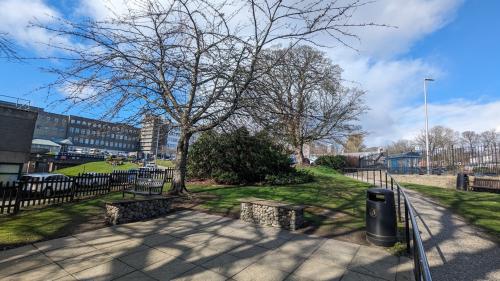Why are health and wellbeing values important?
The UK is made up of stocks of elements of nature that have a value to society. This natural capital provides ecosystem services that contribute to the health and wellbeing of users, staff, and wider communities.
NHS Scotland natural capital is made up of a combination of green and blue spaces within NHS sites. Green spaces can range from gardens with benches outside many GP Surgeries and NHS Hospitals to extensive areas with paths for people to walk and exercise, like in Ayr’s Ailsa Hospital. Blue spaces are areas that feature water like streams or ponds, such as the burns near Edinburgh’s Royal Hospital for Children & Young People and Royal Infirmary of Edinburgh.
There are potentially significant health and wellbeing benefits that come from the use of these sites for recreation and leisure. However, the monetary value of these benefits to society, and across different users, is not known. Obtaining these values could serve as a guide for future decisions about the use of NHS outdoor spaces in Scotland.
How can we do this?
Estimating the monetary value of the use of NHS spaces for recreation is not straightforward. Research approaches used for similar green spaces (like parks and woodlands) were designed to estimate the value of spaces that are used in very different ways to NHS outdoor areas. For example, unlike visits and trips to a national park, it is likely most NHS outdoor space will be used when a person is visiting an NHS site for another (non-recreation) reason.
To overcome this challenge, using existing Office for National Statistics (ONS) guidance we have designed two different cross-sectional surveys to explore how NHS outdoor space is used and estimate monetary values amongst the Scottish general public and NHS Scotland staff.
These surveys build on the Scotland’s People and Nature Survey (SPANS) and combine observational data and economic experiments to estimate the value of different NHS outdoor spaces. First, the surveys adapt a method used on the ONS to estimate the effect on a person’s health based on how much time people they spend in nature (see White et al. 2019).
Second, the surveys also include bespoke economic methods, such as Contingent Valuation and Contingent Behaviour, which are commonly used to obtain monetary values for environmental services. These methods directly ask people about their behaviour and how they value different types of outdoor spaces.
Designing the surveys has been a thought provoking and exciting process. The research team, which includes Mélanie Antunes from HERU and Neil Chalmers from PHS, have worked closely with colleagues from Public Health Scotland, NatureScot, SEFARI Gateway and NHS National Services Scotland (NSS) to create surveys that we hope are interesting to people and able to answer these questions.
Image: Outdoor space in the Foresterhill Campus (opposite Aberdeen Royal Infirmary with the University of Aberdeen’s Suttie Centre in the back).
Where are we and what are our next steps?
We're currently in the process of obtaining all the necessary ethics approvals. After this, we will test the surveys with members of the public and NHS staff to make sure they are easy to understand and fit-for-purpose.
We will then launch them using representative panels across Scotland and, with the help of Public Health Scotland and NHS NSS, amongst NHS members of staff. If you live in Scotland and/or work at NHS Scotland, keep an eye out for these!
Once we have collected the data, we will analyse the responses and produce a report that will be publicly available on SEFARI’s website. As part of this Fellowship, we are very excited to work with SEFARI Gateway to find interesting and engaging ways to communicate these findings.
We hope the results of this study will inform future decisions in Scotland and contribute to our understanding of how we can measure and value natural capital across the world. Watch this space.
By Luis Loria-Rebolledo, Dwayne Boyers and Verity Watson.
If you have any suggestions or questions, please reach out to us at: nhs-outdoor@abdn.ac.uk
Lead Image: Outdoor space in the Foresterhill Campus – Europe’s largest hospital complex (outside Aberdeen Maternity Hospital). All images are supplied freely for use courtesy of Luis and the Fellowship Team.
